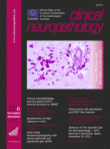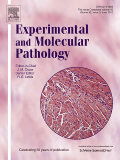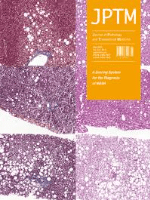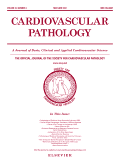
CLINICAL NEUROPATHOLOGY
Scope & Guideline
Shaping the future of neurological pathology through rigorous research.
Introduction
Aims and Scopes
- Neuropathological Studies:
The journal emphasizes in-depth neuropathological examinations of various neurological disorders, including tumors, neurodegenerative diseases, and inflammatory conditions, providing insights into their histological and molecular characteristics. - Clinical Correlations:
Papers often explore the clinical implications of neuropathological findings, linking pathology to patient outcomes and treatment responses, thereby bridging the gap between laboratory research and clinical practice. - Molecular and Genetic Insights:
There is a strong focus on molecular pathology, including studies on genetic mutations, protein expression profiles, and signaling pathways involved in neurological diseases, enhancing the understanding of disease mechanisms. - Case Reports and Series:
The journal publishes detailed case reports and series that highlight unique or rare presentations of neurological diseases, contributing to the body of knowledge and aiding in differential diagnosis. - Emerging Technologies in Neuropathology:
Recent articles reflect an interest in novel methodologies such as molecular imaging, machine learning applications in tumor classification, and advanced histopathological techniques.
Trending and Emerging
- Tumor Microenvironment and Immunology:
Recent papers increasingly explore the tumor microenvironment and immune response in various CNS tumors, highlighting the importance of immunological factors in tumor biology and therapy. - Molecular Characterization of CNS Tumors:
There is a rising trend in studies focusing on the molecular genetics of CNS tumors, including mutations, gene fusions, and epigenetic changes, which are crucial for personalized medicine approaches. - Neuroinflammation and Autoimmune Disorders:
Research on neuroinflammatory processes and their role in autoimmune neurological disorders is gaining prominence, reflecting a growing interest in understanding the intersection between inflammation and neurodegeneration. - Pediatric Neuropathology:
An increase in studies dedicated to pediatric brain tumors and neurological disorders indicates a growing recognition of the unique biological and clinical aspects of these conditions. - Interdisciplinary Approaches in Neuropathology:
Emerging interdisciplinary studies that combine neuropathology with fields such as neurooncology, neuroimmunology, and molecular biology are becoming more prevalent, promoting collaborative research efforts.
Declining or Waning
- General Neuropathological Reviews:
There has been a noticeable decrease in the publication of broad reviews covering general neuropathological concepts, suggesting a shift towards more specialized and focused research articles. - Traditional Histopathological Techniques:
Papers relying solely on conventional histopathological methods without incorporating molecular or advanced imaging techniques are becoming less common, as the field moves towards more integrative approaches. - Epidemiological Studies:
The frequency of epidemiological studies related to neurological diseases has diminished, indicating a potential shift towards more mechanistic and clinical research rather than population-based studies. - Aging and Neurodegeneration:
While still relevant, the focus on aging-related neurodegenerative diseases appears to be waning slightly as new areas of interest, such as brain tumors and molecular pathologies, gain traction.
Similar Journals

EXPERIMENTAL AND MOLECULAR PATHOLOGY
Exploring the depths of disease mechanisms.EXPERIMENTAL AND MOLECULAR PATHOLOGY, a distinguished journal published by Academic Press Inc Elsevier Science, is recognized for its significant contributions to the fields of pathology, clinical biochemistry, and molecular biology. With an ISSN of 0014-4800 and an E-ISSN of 1096-0945, this journal provides a platform for the dissemination of high-quality research articles, reviews, and experimental studies that deepen our understanding of disease mechanisms and diagnostic pathways. Since its inception in 1962 and through its converged publication years, the journal has consistently maintained a solid impact in the academic community, achieving high Scopus rankings—ranked #15 in the field of Pathology and Forensic Medicine and #22 in Clinical Biochemistry, showcasing a commendable percentile standing of 93rd and 81st respectively in 2023. The journal is accessible through various academic libraries and institutional subscriptions, making it an essential resource for researchers, professionals, and students committed to advancing knowledge in these critical areas. With a categorization that includes Q1 rankings in Pathology and Forensic Medicine, EXPERIMENTAL AND MOLECULAR PATHOLOGY stands as a prominent venue for pioneering scientific inquiry and collaborative advancement in molecular diagnostics and therapeutic strategies.

AMERICAN JOURNAL OF SURGICAL PATHOLOGY
Where Cutting-edge Research Meets Clinical PracticeThe American Journal of Surgical Pathology, published by Lippincott Williams & Wilkins, is a premier peer-reviewed journal serving as a vital resource for pathologists, surgeons, and researchers in the medical field. With an impressive impact factor reflective of its esteemed standing in the academic community, the journal ranks in the Q1 quartile for Anatomy, Pathology and Forensic Medicine, and Surgery as of 2023. The journal's Scopus rankings further highlight its significance, placing it within the top tiers in multiple medical disciplines. Established in 1977 and continuing through 2024, its scope encompasses groundbreaking research, critical reviews, and updates in surgical pathology, making it an essential tool for advancing the scientific community's understanding of disease mechanisms and therapeutic approaches. Researchers, clinicians, and students will find both comprehensive studies and innovative insights, ensuring they remain informed about the latest developments in surgical pathology.

PATHOLOGY & ONCOLOGY RESEARCH
Unveiling Insights in Pathology and OncologyPATHOLOGY & ONCOLOGY RESEARCH is a prominent international journal published by FRONTIERS MEDIA SA, dedicated to advancing the fields of pathology and oncology. Operating from the Netherlands, with a distinguished address in Switzerland, this journal plays a crucial role in disseminating significant research findings and insights from 1995 to 2024. With an ISSN of 1219-4956 and E-ISSN of 1532-2807, it is indexed in well-respected databases, facilitating access to a global audience of researchers and practitioners. Notably, the journal ranks in the Q3 category for Cancer Research (2023), while being recognized in the Q2 categories for both Medicine (Miscellaneous), Oncology, and Pathology and Forensic Medicine, reflecting its authoritative status in these vital disciplines. Scopus rankings further highlight its influence, with notable percentiles across various fields. Although it follows a subscription model, the journal remains committed to publishing high-quality, peer-reviewed research that bridges conceptual gaps and encourages further exploration in oncology and diagnostic pathology, making it an indispensable resource for academics and professionals engaged in these critical areas of medicine.

ENDOCRINE PATHOLOGY
Advancing the Future of Endocrine ResearchENDOCRINE PATHOLOGY is a premier journal published by HUMANA PRESS INC, dedicated to advancing the understanding of endocrine disorders through innovative research and clinical practices. With an impressive impact factor and consistently ranked in the Q1 quartile across multiple categories such as Endocrinology, Diabetes and Metabolism, as well as Pathology and Forensic Medicine, this journal serves as a pivotal resource for researchers and professionals in the field. The journal covers a broad spectrum of topics related to endocrine pathology, providing insights into mechanisms, diagnostics, and therapeutics that inform both clinical and laboratory practices. Although it does not offer open access, its rigorous peer-review process ensures the dissemination of high-quality, impactful research that shapes clinical strategies and enhances patient care. With distribution spanning from its inception in 1990 to 2024, ENDOCRINE PATHOLOGY stands at the forefront of endocrine research, making it an essential read for anyone involved in the study and treatment of endocrine disorders.

Journal of Pathology and Translational Medicine
Advancing the Frontiers of Pathology and MedicineThe Journal of Pathology and Translational Medicine, published by the Korean Society of Pathologists, is a distinguished peer-reviewed Open Access journal that has been at the forefront of advancing the field of pathology and histology since its inception in 1985. With an established ISSN of 2383-7837 and an E-ISSN of 2383-7845, the journal serves as a vital platform for disseminating high-quality research, fostering collaboration among professionals and offering valuable insights into both clinical applications and theoretical advancements. Recognized for its influence in the field, it holds a commendable Q2 ranking in both Histology and Pathology & Forensic Medicine categories in 2023, and ranks #52/208 in Scopus for Medicine – Pathology and Forensic Medicine, demonstrating its impact and reach within the academic community. Located in South Korea at 1209 Gwanghwamun Officia, 92 Saemunan-ro, Jongno-gu, Seoul 03186, this journal not only caters to researchers and professionals but also supports students striving to deepen their understanding of pathology. Join the growing body of knowledge and stay updated with the latest findings in this essential field of study through the journal's open access format, promoting worldwide accessibility and engagement.

Brain Hemorrhages
Fostering interdisciplinary research to enhance clinical care.Brain Hemorrhages is a pioneering open-access journal published by KEAI PUBLISHING LTD, dedicated to advancing the field of neurology with a specific focus on brain hemorrhages and their clinical implications. Established in 2020, this journal has quickly gained recognition, achieving a 2023 Q3 category ranking in both neurology and clinical neurology, as well as a Q2 ranking in surgery. With an e-ISSN of 2589-238X, it facilitates broad accessibility, allowing researchers and healthcare professionals worldwide to share and access vital findings without barriers. As it converges its publishing efforts toward 2024, Brain Hemorrhages aims to foster interdisciplinary research and clinical insights that can significantly influence treatment outcomes and enhance patient care. The journal stands as a critical resource for those exploring the complexities of brain hemorrhages, making it an essential addition to any academic or professional library within the fields of neurology and surgery.

CARDIOVASCULAR PATHOLOGY
Innovating research for a healthier heart.CARDIOVASCULAR PATHOLOGY, published by Elsevier Science Inc, is a distinguished journal dedicated to the dissemination of high-quality research in the fields of cardiology, pathology, and cardiovascular medicine. With an ISSN of 1054-8807 and an E-ISSN of 1879-1336, this journal has established itself as a vital resource for researchers, clinicians, and students alike. It is positioned in the Q2 quartile for both cardiology and pathology, indicating its significant impact and relevance in these disciplines. The journal offers a platform for innovative studies, reviews, and clinical insights, aiming to enhance our understanding of cardiovascular conditions and their pathological underpinnings. With an H-index that showcases its scholarly influence, CARDIOVASCULAR PATHOLOGY is committed to advancing the field through rigorous peer review and open dialogue among professionals. The journal is accessible through institutional subscriptions, making it an essential reference point for ongoing research through its convergence of knowledge from 1992 through 2024.

ACTA NEUROPATHOLOGICA
Unraveling the Complexities of the Nervous SystemACTA NEUROPATHOLOGICA, published by Springer, is a leading journal in the fields of cellular and molecular neuroscience, clinical neurology, and pathology, recognized for its exceptional quality and impactful research. With an impressive impact factor and currently ranked in the Q1 tier across multiple categories in 2023, this journal serves as a premier platform for the dissemination of groundbreaking findings in neuropathology. The journal's robust Scopus rankings highlight its influence, standing at #2 in Pathology and Forensic Medicine and #5 in Clinical Neurology. Since its inception in 1961, ACTA NEUROPATHOLOGICA has provided crucial insights into neurological diseases and disorders, contributing significantly to the advancement of medical science. Aimed at researchers, practitioners, and students alike, this journal fosters a deeper understanding of neurological conditions and encourages innovative approaches within the field. It is essential reading for anyone dedicated to unraveling the complexities of the nervous system.

International Journal of Clinical and Experimental Pathology
Connecting Researchers and Practitioners in PathologyInternational Journal of Clinical and Experimental Pathology, published by E-CENTURY PUBLISHING CORP, serves as a vital resource for professionals in the field of pathology. With its ISSN 1936-2625, the journal has positioned itself within the competitive landscape of medical journals, achieving commendable rankings in Scopus, particularly in the categories of Pathology and Forensic Medicine (Rank #98/185) and Histology (Rank #38/58). Although its coverage in Scopus has been discontinued, the journal’s past contributions from 2009 to 2017 continue to be a touchstone for researchers interested in advancing their understanding of clinical and experimental pathology. The open-access format ensures accessibility to a wide audience, fostering collaboration and education in this essential medical discipline. By bridging clinical research and experimental findings, this journal plays a crucial role in disseminating knowledge and enhancing practices within pathology, making it an indispensable tool for researchers, professionals, and students alike.

Medical Molecular Morphology
Unlocking the Mysteries of Molecular Morphology.Medical Molecular Morphology, published by SPRINGER JAPAN KK, stands as a significant resource in the fields of medicine and molecular biology, bridging critical insights between histological studies and modern therapeutic approaches. With an ISSN of 1860-1480 and E-ISSN of 1860-1499, this journal has evolved since its inception in 1996 and has continued to provide a platform for innovative research through 2024, establishing its relevance particularly in the realms of medical pathology and molecular morphology. Although categorized as Q3 in Medicine (miscellaneous) and Q4 in Molecular Biology per the 2023 quartiles, the journal's unique contributions cannot be understated, as evidenced by its Scopus rankings, which place it in the 52nd percentile for Pathology and 19th percentile for Molecular Biology. The journal’s mission focuses on disseminating valuable findings that enhance the understanding of cellular and molecular structures and their implications in health and disease. As access options are not currently open access, it remains essential for professionals and researchers to consider the journal's contributions as they pursue academic growth and impactful research in these dynamic fields.